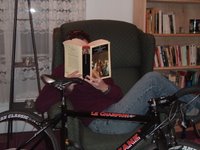I finished Cloud Atlas, and if there any of my readers who haven’t yet gotten to this book, I can recommend it highly. It has an experimental structure: made up of six different stories, they are nestled like Russian dolls, with one story in the middle and the others, broken in two, surrounding it. Mitchell relates this structure to the nature of time:One model of time: an infinite matryoshka doll of painted moments, each “shell” (the present) encased inside a nest of “shells” (previous presents) I call the actual past but which we perceive as the virtual past. The doll of “now” likewise cases a nest of presents yet to be, which I call the actual future but which we perceive as the virtual future.
The past, present, and future, although seemingly distinct, really form one whole, and the six stories of this book, each very different, form a unity. I had a couple of worries about this book before I began; one, that it would feel like a postmodern trick but not be that interesting as a story, not that emotionally engaging, and two, that it would feel more like a short story collection than a novel, when what I wanted was a novel. But neither of these worries stayed with me: the stories were engaging and they linked together to make the book feel coherent, and it wasn’t simply postmodern trickery, but was emotionally engaging. I do, often, consider these things mutually exclusive, and assume that something postmodernist is going to be a bit dry and sterile. That’s a mistake, I’m guessing, or at least an assumption that, if explored, would get me into considering the definition of “postmodern,” a direction I’m not going to go in right now.
The book was smart – not merely in a dazzling, show-offy way (although there’s inevitably a show-offy element with this kind of structure), but with ideas about what, ultimately, humans are really like – are we just like animals, or is there something more to us? Or less? It’s about predators and prey, war and technology and how we are ruining the earth. It’s that kind of big novel, which makes a statement about where human beings are headed, and the picture isn’t pretty, for the most part.
Some of the stories take place in the past and some in the far-off future, so Mitchell gets a chance to speculate on our trajectory and to think about cycles of human history, where greed and selfishness on a grand scale lead to destruction, and the hope of humanity lies in the hands of a few people. I suppose in this sense the novel is more Romantic than Postmodern – idealistic about the effects individuals can have on history. It’s got the structural experimentation we associate with postmodernism, but it still believes, ultimately, in the power of individual people acting on the world. Not that the book is overly optimistic, by any means. But it explores the effects, however small, of people who try to hang on to some kind of ideal. These characters are often hapless, trying to do one thing and accomplishing another – failing to do the good thing they had wanted to but intentionally succeeding in something much better. This haplessness is often moving.
And the book is smart in another way: Mitchell draws on various modes of storytelling, and creates a series of very different voices, proving his dexterity with language. We get a Victorian-era travelogue, a thriller set in the 70s, and a dystopian vision of the future, among other forms. Each one is well done and convincing.
The stories often become reflections on writing and stories themselves: one of them becomes a movie a later character watches, and another story we find out is a book manuscript submitted to a publisher who is the main character of a later story. The plot of one of the stories revolves around various characters trying desperately to get their hands on a manuscript that would incriminate a nuclear power company trying to build a reactor. The story set farthest off in the future – the “end,” although it is really in the middle of the book – closes with characters hanging on to the remains of an earlier story, not fully understanding it, but listening to it nonetheless. It is narrative that connects these stories, and narrative and memory that offers any hope.
Here is a quotation that partly explains the novel’s title:Souls cross ages like clouds cross skies, an’ tho’ a cloud’s shape nor hue nor size don’t stay the same, it’s still a cloud an’ so is a soul. Who can say where the cloud’s blowed from or who the soul’ll be ‘morrow? Only Sonmi the east an’ the west an’ the compass an’ the atlas, yay, only the atlas o’ clouds.
I like this description of the soul – changeable, moving, unknowable, with uncertain borders, but something we can recognize nonetheless.
Friday, May 19, 2006
Cloud Atlas
Posted by
Rebecca H.
at
8:34 AM
![]()
Subscribe to:
Comment Feed (RSS)



|